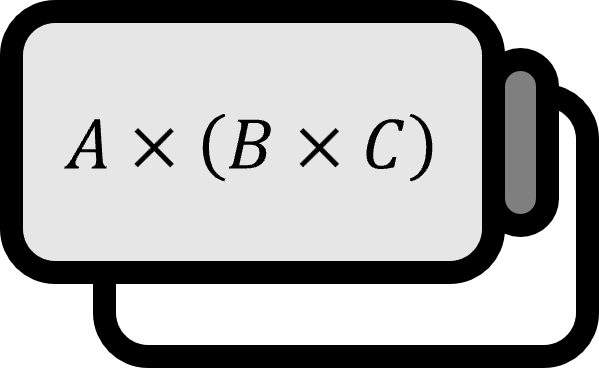직교좌표계 단위벡터를 구면좌표계의 단위벡터로 나타내기
공식
직교좌표계의 단위벡터를 구면좌표계의 단위벡터로 나타낸 식은 아래와 같다. $$ \begin{align*} \hat{ \mathbf{x} }&= \cos \phi \sin \theta \hat{ \mathbf{r} } + \cos \phi \cos \theta \hat{ \boldsymbol{\theta} } - \sin\phi\hat{ \boldsymbol{\phi} } \\ \hat{ \mathbf{y} } &= \sin\phi\sin\theta \hat{ \mathbf{r} } + \sin\phi\cos\theta\hat{ \boldsymbol{\theta} } + \cos\phi\hat{ \boldsymbol{\phi} } \\ \hat{ \mathbf{z} } &= \cos\theta\hat{ \mathbf{r} } - \sin\theta\hat{ \boldsymbol{\theta} } \end{align*} $$
구면좌표계의 단위벡터를 직교좌표계의 단위벡터로 나타내면 아래와 같다. (구면좌표계와 직교좌표계의 관계)
$$ \begin{align*} \hat{ \mathbf{r} } &= \cos\phi \sin\theta \hat{ \mathbf{x} } + \sin\phi \sin\theta\hat{ \mathbf{y} } + \cos\theta\hat{ \mathbf{z} } \\ \hat{ \boldsymbol{\theta} } &= \cos\phi \cos\theta \hat{ \mathbf{x} } + \sin\phi \cos\theta\hat{ \mathbf{y} } - \sin\theta\hat{ \mathbf{z} } \\ \hat{ \boldsymbol{\phi} } &= -\sin\phi \hat{ \mathbf{x} } + \cos\phi \hat{ \mathbf{y} } \end{align*} $$
유도
단위벡터 $\hat{\mathbf{x}}$
$\hat{ \mathbf{x} }$을 구하려면 $\hat{ \mathbf{r} } ,\ \hat{ \boldsymbol{\theta} } ,\ \hat{ \boldsymbol{\phi} }$에 적당한 수를 곱한뒤 더했을 때 $\hat{ \mathbf{y} } ,\ \hat{ \mathbf{z} }$항이 사라지도록 하면 된다. 살펴보면 $\hat{ \mathbf{r} }$에 $\sin \theta$를 곱하고 $\hat{ \boldsymbol{\theta} }$에 $\cos \theta$를 곱해서 더해주면 $\hat{ \mathbf{z} }$항이 사라짐을 알 수 있다.
$$ \begin{align*} & \sin \theta \hat{ \mathbf{r} } + \cos \theta \hat{ \boldsymbol{\theta} } \\ &= (\cos \phi \sin^2 \theta + \cos \phi \cos^2\theta)\hat{ \mathbf{x} } + (\sin \phi \sin^2 \theta + \sin \phi \cos^2 \theta)\hat{ \mathbf{y} } \\ &= \cos \phi \hat{ \mathbf{x} } +\sin \phi \hat{ \mathbf{y} } \end{align*} $$
또 이렇게 나온 결과에 $\cos \phi$를 곱하고 $\hat{ \boldsymbol{\phi} }$에 $-\sin \phi$를 곱해서 더해주면 깔끔하게 $\hat{ \mathbf{x} }$를 구할 수 있다.
$$ \begin{align*} & \cos \phi (\sin \theta \hat{ \mathbf{r} } + \cos \theta \hat{ \boldsymbol{\theta} })-\sin \phi \hat{ \boldsymbol{\phi} } \\ &= (\cos^2\phi \hat{ \mathbf{x} } + \cos \phi \sin \phi \hat{ \mathbf{y} } ) + (\sin^2\phi \hat{ \mathbf{x} } -\sin \phi \cos \phi \hat{ \mathbf{y} } ) \\ &= \hat{ \mathbf{x} } \end{align*} $$
따라서 정리하면 아래와 같다.
$$ \hat{ \mathbf{x} } = \cos \phi \sin \theta \hat{ \mathbf{r} } + \cos \phi \cos \theta \hat{ \boldsymbol{\theta} } - \sin\phi\hat{ \boldsymbol{\phi} } $$
단위벡터 $\hat{\mathbf{y}}$
방법은 $\hat{ \mathbf{x} }$의 경우와 같으니 설명없이 수식만 적겠다. $\hat{ \mathbf{z} }$항을 없애는 부분은 $\hat{ \mathbf{x} }$의 경우와 같다.
$$ \begin{align*} &&\sin \theta \hat{ \mathbf{r} } + \cos \theta \hat{ \boldsymbol{\theta} } &= \cos \phi \hat{ \mathbf{x} } + \sin \phi \hat{ \mathbf{y} } \\ \implies&& \sin\phi (\sin\theta\hat{ \mathbf{r} }+\cos\theta \hat{ \boldsymbol{\theta} } ) &= \sin \phi \cos \phi \hat{ \mathbf{x} } + \sin^2\phi \hat{ \mathbf{y} } \end{align*} $$
이고
$$ \cos \phi \hat{ \boldsymbol{\phi} }=-\sin\phi\cos\phi\hat{ \mathbf{x} }+\cos^2\phi\hat{ \mathbf{y} } $$
이므로 다음과 같다.
$$ \begin{align*} && \sin\phi (\sin\theta\hat{ \mathbf{r} }+\cos\theta \hat{ \boldsymbol{\theta} } )+\cos \phi \hat{ \boldsymbol{\phi} } &= (\cos^2\phi + \sin^2\phi )\hat{ \mathbf{y} } \\ && &= \hat{ \mathbf{y} } \end{align*} $$
$$ \therefore \hat{ \mathbf{y} } = \sin\phi\sin\theta \hat{ \mathbf{r} } + \sin\phi\cos\theta \hat{ \boldsymbol{\theta} } + \cos\phi \hat{ \boldsymbol{\phi} } $$
단위벡터 $\hat{\mathbf{z}}$
$\hat{ \mathbf{z} }$항이 남아야 하므로 $\hat{ \mathbf{r} }$에 $\cos\theta$를 곱하고 $\hat{ \boldsymbol{\theta} }$에 $-\sin\theta$를 곱해서 더하면 아래와 같다.
$$ \begin{align*} \cos\theta\hat{ \mathbf{r} } -\sin\theta \hat{ \boldsymbol{\theta} } &=\cos\theta (\cos \phi \sin \theta \hat{\mathbf{x}}+\sin \phi \sin \theta \hat{\mathbf{y}}+\cos\theta\hat{\mathbf{z}}) \\ &\quad -\sin \theta (\cos \phi \cos \theta \hat{\mathbf{x}} + \sin \phi \cos \theta \hat{\mathbf{y}} -\sin \theta \hat{\mathbf{z}}) \\ &= (\sin\theta\cos\theta\cos\phi \hat{ \mathbf{x} } + \sin\theta\cos\theta\sin\phi \hat{ \mathbf{y} }+ \cos^2\theta \hat{ \mathbf{z} }) \\ &\quad +(-\sin\theta\cos\theta\cos\phi \hat{ \mathbf{x} }-\sin\theta\cos\theta\sin\phi \hat{ \mathbf{y} } + \sin^2{\theta} \hat{ \mathbf{z} }) \\ &= (\cos^2\theta + \sin ^2 \theta ) \hat{ \mathbf{z} } \\ &= \hat{ \mathbf{z} } \end{align*} $$
$$ \therefore \hat{ \mathbf{z} } = \cos\theta\hat{ \mathbf{r} } - \sin\theta \hat{ \boldsymbol{\theta} } $$

 저희들의 저서 「줄리아 프로그래밍」이 2024 세종도서 학술부문에 선정되었습니다!
저희들의 저서 「줄리아 프로그래밍」이 2024 세종도서 학술부문에 선정되었습니다!

